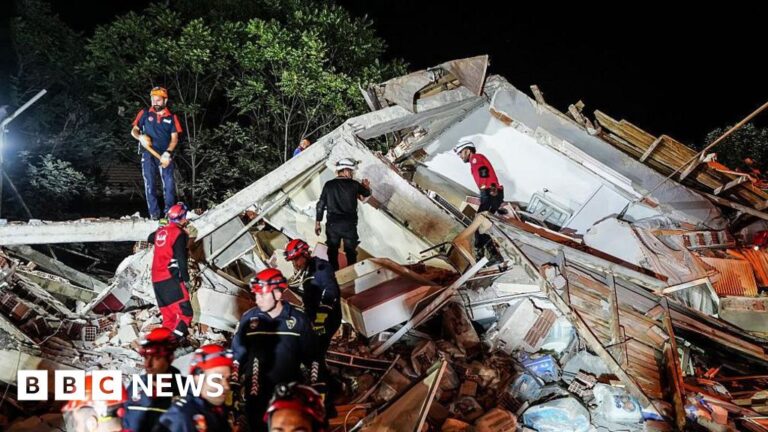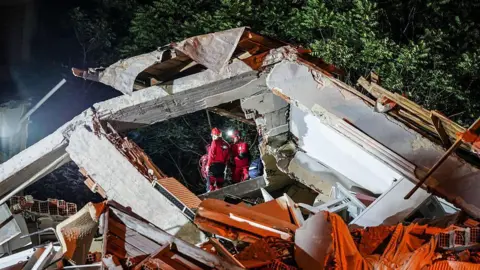BBC News
 Al Jazeera
Al JazeeraFive Al Jazeera journalists have been killed in an Israeli strike near Gaza City’s Al-Shifa Hospital, the broadcaster has said.
Correspondents Anas al-Sharif and Mohammed Qreiqeh, alongside cameramen Ibrahim Zaher, Mohammed Noufal and Moamen Aliwa were in a tent for journalists at the hospital’s main gate when it was struck, Al Jazeera reported.
The “targeted assassination” on Sunday was “yet another blatant and premeditated attack on press freedom”, it said in a statement.
Shortly after the strike, the Israel Defense Forces (IDF) confirmed that it had targeted Anas al-Sharif, writing in a Telegram post that he had “served as the head of a terrorist cell in Hamas”.
The IDF did not mention any of the other journalists who were killed.
In total, seven people died in the strike, Al Jazeera reports. The broadcaster initially said that four of its staff had been killed, but revised it to five a few hours later.
Its managing editor, Mohamed Moawad, told the BBC that al-Sharif was an accredited journalist who was “the only voice” for the world to know what was happening in the Gaza Strip.
Throughout the war, Israel has not allowed international journalists into Gaza to report freely. Therefore, many outlets rely on local reporters within the territory for coverage.
“They were targeted in their tent, they weren’t covering from the front line,” Moawad said of the Israeli strike.
“The fact is that the Israeli government is wanting to silence the coverage of any channel of reporting from inside Gaza,” he told The Newsroom programme.
“This is something that I haven’t seen before in modern history.”
Al-Sharif, 28, appeared to be posting on X in the moments before his death, warning of intense Israeli bombardment within Gaza City. A post that was published after he was reported to have died appears to have been pre-written and published by a friend.
In two graphic videos of the aftermath of the strike, which have been confirmed by BBC Verify, men can be seen carrying the bodies of those who were killed.
Some shout out Qreiqeh’s name, and a man wearing a media vest says that one of the bodies is that of al-Sharif.
 Ebrahim Hajjaj/ Reuters
Ebrahim Hajjaj/ ReutersIn its statement, the IDF accused al-Sharif of posing as a journalist, and being “responsible for advancing rocket attacks against Israeli civilians and IDF troops”.
It said it had previously “disclosed intelligence” confirming his military affiliation, which included “lists of terrorist training courses”.
Last month, the Al Jazeera Media Network – along with the United Nations and the Committee to Protect Journalists (CPJ) – issued separate statements warning that al-Sharif’s life was in danger, and calling for his protection.
Jodie Ginsberg, chief executive of the CPJ, told the BBC that Israeli authorities have failed to provide evidence to show that the journalists they killed were terrorists.
“This is a pattern we’ve seen from Israel – not just in the current war, but in the decades preceding – in which typically a journalist will be killed by Israeli forces and then Israel will say after the fact that they are a terrorist, but provides very little evidence to back up those claims,” she said.
This is not the first time the IDF has targeted and killed Al Jazeera journalists in Gaza, who they claimed were Hamas-affiliated.
In August last year, Ismael Al-Ghoul was hit by an air strike as he sat in his car – harrowing video shared on social media showed his decapitated body. Cameraman Rami al-Rifi and a boy passing on a bicycle were also killed.
In al-Ghoul’s case, the IDF said he took part in Hamas’ 7 October 2023 attacks against Israel, a claim Al Jazeera strongly rejected.
According to the CPJ, 186 journalists have been confirmed killed since the start of Israel’s military offensive in Gaza in October 2023.
For the journalists still in Gaza, the situation is dire. As well as air strikes, there is the threat of starvation.
Last month, the BBC and three news agencies – Reuters, AP and AFP – issued a joint statement expressing “desperate concern” for journalists in the Strip, who they say are increasingly unable to feed themselves and their families.
Three freelancers whom the BBC relies on for its coverage said they often go days without eating, and one collapsed during filming.
More than 100 international aid organisations and human rights groups have warned of mass starvation in Gaza. Israel, however, which controls the entry of aid supplies into Gaza, has accused the charities of “serving the propaganda of Hamas”.
Israel launched its offensive in response to the Hamas-led attack on southern Israel on 7 October that year, in which about 1,200 people were killed and 251 others were taken hostage.
More than 61,000 people have been killed in Gaza since the Israeli military operation began, according to the territory’s Hamas-run health ministry.
Additional reporting by Shayan Sardarizadeh, BBC Verify














